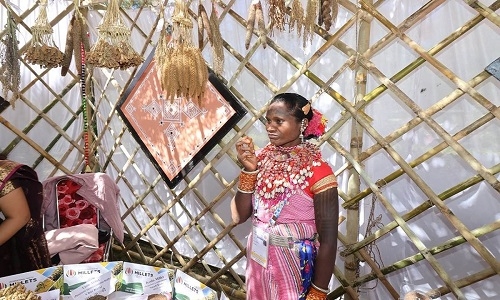Dindori’s Lahari Bai ‘The Millet Woman of India’
| Date :02-Mar-2023 |

By Shivanjali Verma
Her determination to make millets regain their lost glory, has made her famous as ‘Millet Woman of India’ across the country. The 27-year-old Baiga lady, Lahari Bai hails from densely forested village Silpidi in Dindori district, has transformed her home into a ‘Millet Seed Bank’ where she has collected seeds of over 60 varieties of millets in earthen containers. She also distributes these seeds to farmers who grow them and she gets a part of the produce to be preserved in her homemade seed bank.
Her unique mission has also attracted PM Modi’s attention who named her the ‘Brand Ambassador of Millets’.
Earlier, millets were called as ‘Coarse Cereals’ which is now given new status of ‘Shree Ann’ due its qualities of farmer-friendly, low water consuming, climate resilient crop with high nutritional values. Present in her stall in full traditional attire, amid samples of different millets in full traditional finery, Lahari Bai was the centre of attraction during Millet Exhibition organised during National Conference at Jawaharlal Nehru Agriculture University.
“These millets have high nutritional content in comparison to wheat, rice and corns but unfortunately majority of the population are still unfamiliar about its qualities. Thanks to the United Nation’s initiative to declare the year 2023 as the ‘Year Of Millets’ at India’s insistence”, said Lahari Bai.
“My parents equally participate in my work as they are also concerned about disappearing local varieties of millets and decided to protect it for the future generation”, said Lahari Bai who initiated her Bank 10 years back in which she collected and conserved many nutri-cereals or dryland cereals, including sorghum, pearl millet, ragi, small millet, foxtail millet, proso millet, barnyard millet, kodo millet and other millets.
I have seen the magic of these millets as the members of my community back home enjoy a long healthy life and seldom become ill. Thanks to these “super-foods” as they are nutritionally superior to wheat and rice and can provide nutritional security and work against nutritional deficiency, especially among children and women,” she said.